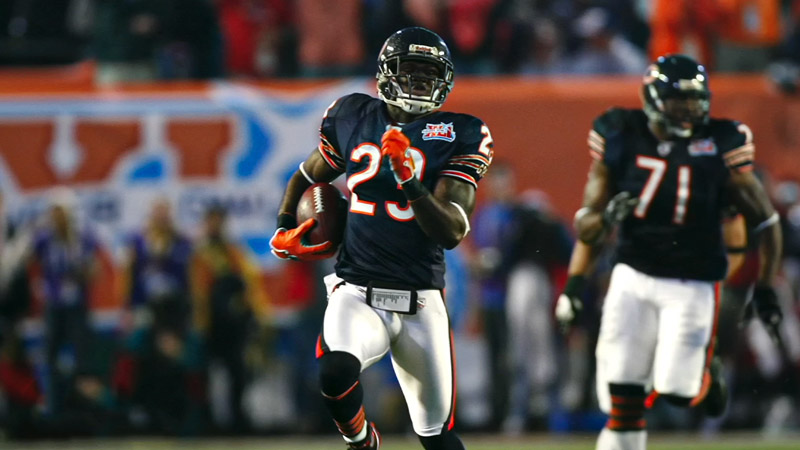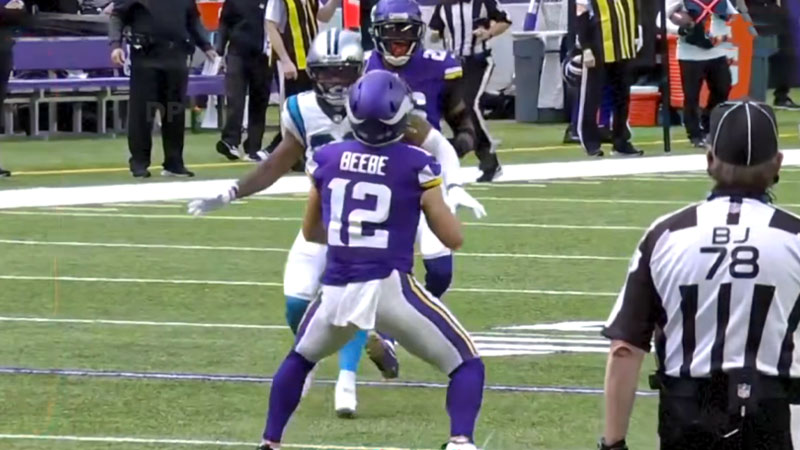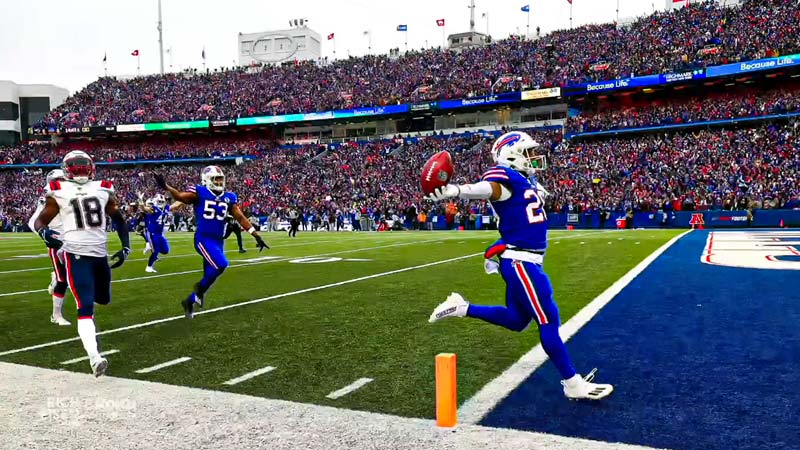American football is a sport renowned for its intensity, strategy, and captivating gameplay. Amidst the adrenaline-fueled tackles and electrifying touchdowns, certain rules have been crafted to safeguard player well-being and maintain the integrity of the game.
One such rule that significantly impacts the dynamics of special teams’ play is the NFL fair catch rule. Designed to strike a balance between player safety and strategic gameplay, the fair catch rule has become a cornerstone of how kickoffs and punts are managed in the National Football League.
In this blog post, we delve into the intricacies of the NFL fair catch rules, addressing five frequently asked questions to provide a comprehensive understanding of its significance within the game.
What Is a Fair Catch in Football?
In football, a fair catch refers to a player’s action of catching an airborne kick, typically a punt or kickoff, without interference from opposing players. To make a fair catch, a player from the receiving team signals their intention by fully extending one arm above their helmet and waving it from side to side.
This signal signifies that the player does not plan to advance with the ball and aims to secure it safely. When a fair catch is made, the receiving team gains possession at the spot of the catch, without any attempt from the kicking team to tackle the catcher.
The fair catch rule emphasizes player safety, preventing dangerous collisions during special teams’ plays, and allows for a controlled transition of possession.
NFL Fair Catch Rules on 2023
In the dynamic and fast-paced game of American football, the fair catch rule serves as a mechanism to ensure player safety and fair play during certain kicking situations.
The National Football League (NFL) has established comprehensive guidelines governing fair catches, which involve catching an airborne scrimmage kick or a free kick without interference from the opposing team.
These rules are meticulously designed to maintain the integrity of the game while safeguarding players from unnecessary risks. Let’s delve into the specifics of NFL fair catch rules, along with the penalties for violating these regulations.
Valid Fair-Catch Signal
A crucial aspect of the fair-catch rule pertains to the validity of the fair-catch signal. To make a valid fair-catch signal, a player from the receiving team must fully extend one arm above their helmet and wave it from side to side.
This signal indicates the player’s intention to catch the ball without any opposition from the kicking team.
It’s essential to note that a receiver can legally raise their hands to shield their eyes from the sun, but they are not permitted to raise their hands above the helmet except when signaling for a fair catch.
Invalid Fair-Catch Signal
An invalid fair-catch signal occurs if a player raises their hands above their shoulders in any manner other than the prescribed signal. In the event of an invalid fair-catch signal, the ball becomes dead once caught or recovered by a member of the receiving team.
However, this situation does not result in an actual fair catch. Importantly, the ball remains live if it contacts an opponent before or after striking the ground.
Notably, a fair-catch signal given behind the line of scrimmage on a scrimmage kick holds no validity and is neither considered valid nor invalid.
Muff and Interference
Even after a valid fair-catch signal, the opportunity to catch a kick doesn’t end if the ball is muffed, i.e., not caught cleanly upon first contact. The player who signaled for the fair catch must still have a reasonable chance to catch the muffed ball before it hits the ground.
This rule aims to prevent interference by members of the kicking team, irrespective of whether the ball hits another player or an official.
Intentional Muff
Attempting to intentionally muff the ball forward before catching it with the intention of gaining yardage is deemed an illegal act known as an “illegal bat.”
This rule prevents players from exploiting the fair catch rule to their advantage by strategically muffing the ball to gain additional yardage.
Illegal Block
A player who executes a valid or invalid fair-catch signal is prohibited from initiating contact with a player of the kicking team until the ball touches a teammate or an opponent.
This rule is established to prevent undue physical confrontation during the fair catch attempt.
Penalties for Violating NFL Fair Catch Rules

The National Football League (NFL) has established a comprehensive set of rules that govern fair Play catches, accompanied by penalties designed to uphold the integrity of the game and prevent violations that could lead to an unfair advantage or jeopardize player safety.
These penalties act as a deterrent, fostering a level playing field for all teams involved. Here are the penalties players usually get for violating the rules.
Invalid Fair-Catch Signal Penalty
An integral aspect of the fair Play catch rule revolves around the validity of the fair-catch signal. If a player makes an invalid fair-catch signal, the NFL imposes a penalty of a loss of five yards from the spot of the signal.
This penalty emphasizes the importance of adhering to the prescribed signal and discourages players from attempting to deceive opponents or officials.
The enforcement of this penalty underscores the significance of fair play and adherence to rules that govern player conduct.
Scenario: If a player raises their hand(s) above their shoulder(s) in a manner inconsistent with the proper fair-catch signal, they trigger an invalid fair-catch signal. For instance, a player attempting to mimic a fair-catch signal without fully extending their arm above their helmet would incur this penalty.
Interference After a Muff Penalty
In instances where interference occurs after a player has muffed the ball following a valid fair-catch signal, a unique penalty comes into play.
This penalty awards the receiving team a fair catch at the spot of interference, even if the ball is not ultimately caught.
By doing so, the NFL ensures that players who have rightfully signaled for a fair catch are given an unimpeded chance to recover the muffed ball without facing unwarranted obstructions from the kicking team.
Scenario: Suppose a player from the kicking team attempts to obstruct the player who signaled for a fair catch after that player muffs the ball. This interference hinders the fair catch opportunity, prompting the enforcement of this penalty.
Intentional Muff Penalty
Engaging in an intentional muff forward before making a catch in an effort to gain yardage constitutes a violation known as an “illegal bat.”
The penalty for this action underscores the NFL’s commitment to preserving the genuine spirit of the game and preventing tactical manipulations that could lead to unfair advantages.
By penalizing intentional muffs aimed at altering the trajectory of the ball, the NFL ensures that teams do not exploit the fair catch rule for strategic gains.
Scenario: If a player intentionally muffs the ball forward after a fair-catch signal to create a more favorable field position upon recovering the ball, they would incur an intentional muff penalty.
Illegal Block Penalty
The NFL places restrictions on players who have executed valid or invalid fair-catch signals from initiating contact with players from the kicking team until the ball makes contact with a teammate or opponent. Initiating contact in violation of this rule results in an illegal block penalty.
This penalty, entailing a loss of 15 yards from the spot of the foul, discourages aggressive actions that could lead to injuries or unfairly impact the outcome of the play.
Scenario: If a player from the receiving team blocks a member of the kicking team before the ball touches any player, teammate, or opponent, they would incur an illegal block penalty.
The NFL’s penalties for violating fair catch rules play a vital role in maintaining the essence of fair play, safety, and sportsmanship in American football.
Impact of the Fair Play Catch in the NFL

The fair catch rule in the NFL has a profound impact on various aspects of the game, ranging from player safety to strategic gameplay and the overall dynamics of special teams.
This rule, designed to ensure fairness and reduce the risk of injuries, plays a significant role in shaping the flow of American football.
Player Safety
One of the primary motivations behind implementing the fair catch rule is to enhance player safety. Football is a physically demanding sport, and high-speed collisions are common during kickoffs and punts.
By allowing a player to signal for a fair catch, the rule provides a mechanism for a safe and unobstructed opportunity to catch the ball without facing immediate contact from opposing players.
This reduces the likelihood of dangerous collisions, concussions, and other injuries that can occur in high-impact scenarios.
Game Strategy
The fair catch rule adds an element of strategy to the game, both for the receiving team and the kicking team. For the receiving team, deciding whether to attempt a return or signal for a fair catch involves evaluating field position, game situation, and the potential for a successful return.
On the other hand, the kicking team must decide whether to kick deep and risk a return or aim for optimal ball placement to encourage a fair catch. This strategic interplay adds depth and complexity to the game’s tactics.
Field Position
Fair catches influence field position, a crucial factor in American football. When a player successfully signals for a fair catch, the receiving team gains possession of the ball at the spot of the catch.
This can impact a team’s starting field position and subsequently influence their offensive strategy.
Teams may opt for a fair catch in situations where they want to secure possession without risking potential turnovers or poor field position.
Special Teams
The fair catch rule is a cornerstone of special teams’ play, a distinct facet of football that involves kickoffs, punts, and field goals. Special teams units have unique personnel and strategies tailored to these situations.
The rule guides special teams players in their roles, such as positioning for a potential return or preparing to down the ball when a fair catch is signaled.
The fair catch rule also introduces new dimensions for special teams coaches to develop innovative tactics.
Reduced On-Field Chaos
During punt returns, the fair catch rule contributes to reducing on-field chaos. Without this rule, players from the kicking team would be in close proximity to the receiver as they attempt to catch the ball, leading to potential collisions and interference.
The fair catch signal ensures that players have a designated space to catch the ball without immediate pressure, enhancing their chances of cleanly securing possession.
Momentum and Momentum Shifts
A successful fair catch can influence the momentum of a game. By securing the ball without risking a fumble or turnover, the receiving team maintains possession and potentially shifts momentum in their favor.
Conversely, a well-executed kick with limited return opportunities can provide the kicking team with a favorable field position and momentum.
Sportsmanship and Respect
The fair catch rule also emphasizes the principles of sportsmanship and respect among players. When a player signals for a fair catch, the opposing team is expected to allow them an unobstructed opportunity to catch the ball.
This showcases the sportsmanship ingrained in the game and reflects the mutual respect that players have for one another’s safety and well-being.
FAQs
What is a fair catch in the NFL, and how is it signaled?
A fair catch in the NFL refers to an unhindered catch of an airborne scrimmage kick that has crossed the line of scrimmage or an airborne free kick by a player of the receiving team.
This catch is made without any interference from the kicking team. A fair catch is valid if a player fully extends one arm above their helmet and waves it from side to side.
This distinct signal ensures that players have an opportunity to catch the ball without being immediately tackled, promoting both safety and fairness.
What happens if a player makes an invalid fair-catch signal?
If a player raises their hand(s) above their shoulder(s) in any manner other than the prescribed fair-catch signal, it is considered an invalid fair-catch signal.
In this scenario, the ball is dead when caught or recovered by any player of the receiving team, but it is not treated as a fair catch.
To deter such actions, the NFL enforces a penalty of a loss of five yards from the spot of the invalid signal, highlighting the importance of adhering to the proper signal.
How does the fair catch rule impact player safety?
The fair catch rule plays a significant role in enhancing player safety. Football is known for its high-impact collisions, particularly during kickoffs and punts.
Allowing a player to signal for a fair catch ensures that they can catch the ball without immediate contact from opponents. This reduces the risk of injuries caused by high-speed collisions, safeguarding players’ well-being in situations that carry inherent risks.
Can a player still attempt to return the ball after signaling for a fair catch?
After signaling for a valid fair catch, a player has the option to attempt a return if they choose to do so. The fair catch signal provides players with a strategic decision-making opportunity.
Factors such as field position, game situation, and the potential for a successful return influence whether a player chooses to catch the ball or let it bounce, possibly leading to a better field position.
How does the fair catch rule impact special teams’ gameplay?
The fair catch rule significantly impacts special teams gameplay, which involves kickoffs, punts, and field goals. Special teams units have specific personnel and tactics for these situations.
The fair catch rule guides players on positioning for potential returns and informs strategies for both the receiving and kicking teams. This dynamic adds an extra layer of strategy and complexity to special teams’ play.
Wrapping Up
In the intricate tapestry of American football, the NFL fair catch rule stands as a testament to the league’s commitment to player safety, fair competition, and strategic gameplay.
By allowing players to signal for a fair catch, the rule ensures that each side has a chance to catch the ball without facing immediate contact. This mechanism simultaneously enhances player safety and introduces strategic decision-making moments that add depth to the game.
As football continues to evolve, the fair catch rule remains a pivotal aspect that reflects the balance between the fierce competitiveness of the sport and the priority placed on the well-being of its athletes.







